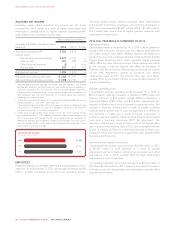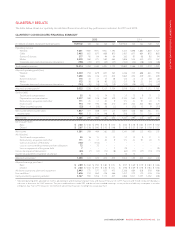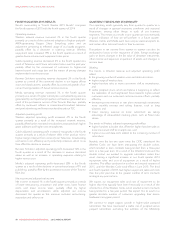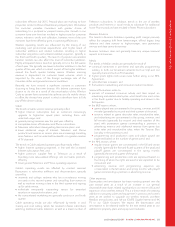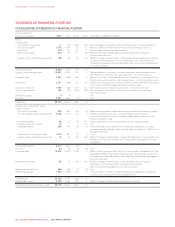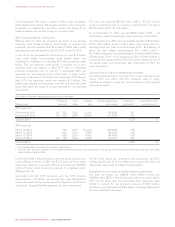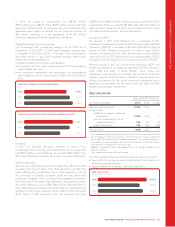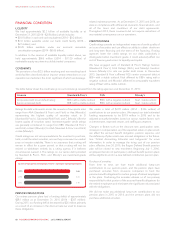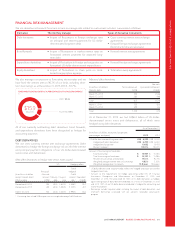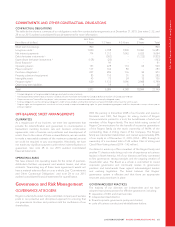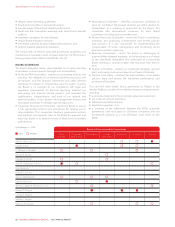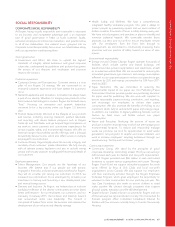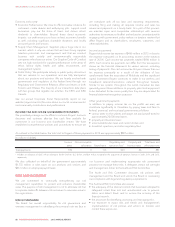Rogers 2015 Annual Report Download - page 64
Download and view the complete annual report
Please find page 64 of the 2015 Rogers annual report below. You can navigate through the pages in the report by either clicking on the pages listed below, or by using the keyword search tool below to find specific information within the annual report.
MANAGEMENT’S DISCUSSION AND ANALYSIS
BOND FORWARDS
From time to time, we use extendible bond forward derivatives
(bond forwards) to hedge interest rate risk on the debt instruments
we expect to issue in the future. As at December 31, 2015,
approximately $5.5 billion of our outstanding public debt matures
over the next five years (2014 – $5.2 billion) and we anticipate that
we will issue public debt over that time to fund at least a portion of
those maturities together with other general corporate funding
requirements. We use bond forwards for risk management
purposes only. The bond forwards noted below have been
designated as hedges for accounting purposes.
During 2014, we entered into bond forwards to hedge the
underlying Government of Canada (GoC) interest rate risk that will
comprise a portion of the interest rate risk associated with our
anticipated future debt issuances. As a result of these bond
forwards, we hedged the underlying GoC 10-year rate on
$1.5 billion notional amount for anticipated future debt issuances
from 2015 to 2018 and the underlying GoC 30-year rate on
$0.4 billion notional amount for December 31, 2018. The bond
forwards are effective from December 2014.
On December 8, 2015, we exercised the $500 million notional
bond forward due December 31, 2015 in relation to the issuance
of the US$700 million senior notes due 2025 and paid $25 million
to settle the derivative. The amount paid represents the fair value of
the bond forward at the time of settlement and will be amortized to
finance costs over the life of the $700 million senior notes due
2025. For our remaining bond forwards, we reset the rates and
extended the next re-pricing dates.
As at December 31, 2015 we had $1.4 billion notional amount of bond forwards outstanding (2014 – $1.9 billion), all of which were
designated as hedges for accounting purposes.
(In millions of dollars, except interest rates)
GoC term (years) Effective date Maturity date 1
Notional
amount
Hedged GoC
interest rate as at
December 31, 2015
Hedged GoC
interest rate as at
December 31, 2014 12015 2014
10 December 2014 December 31, 2015 500 – 2.05% –500
10 December 2014 January 4, 2017 500 2.34% 2.04% 500 500
10 December 2014 April 30, 2018 500 2.23% 2.07% 500 500
30 December 2014 December 31, 2018 400 2.52% 2.41% 400 400
Total 1,900 1,400 1,900
1Bond forwards with maturity dates beyond December 31, 2015 are subject to GoC rate re-setting from time to time. The $500 million due April 2018 was extended in October
2015 to reset in April 2016. The $500 million due January 2017 was extended in December 2015 to reset in January 2017. The $400 million due December 2018 was extended in
December 2015 to reset in January 2017.
EXPENDITURE DERIVATIVES
We use foreign currency forward contracts (expenditure derivatives)
to hedge the foreign exchange risk on the notional amount of certain
forecasted US dollar-denominated expenditures. The table below
shows the expenditure derivatives into which we entered to manage
foreign exchange risk related to certain forecasted expenditures.
(In millions of dollars, except exchange rates)
Notional trade date Maturity dates
Notional
amount
(US$)
Exchange
Rate
Converted
amount
(Cdn$)
April 2015 July 2015 to
December 2016 270 1.2222 330
June 2015 January 2016 to
December 2016 60 1.2167 73
September 2015 January 2016 to
December 2016 360 1.3194 475
October 2015 January 2017 to
December 2017 300 1.2933 388
Total during 2015 990 1.2788 1,266
February 2014 January 2015 to
April 2015 200 1.1100 222
May 2014 May 2015 to
December 2015 232 1.0948 254
June 2014 January 2015 to
December 2015 288 1.0903 314
July 2014 January 2016 to
December 2016 240 1.0833 260
Total during 2014 960 1.0940 1,050
The expenditure derivatives noted above have been designated as
hedges for accounting purposes. In the year ended December 31,
2015, we settled US$810 million (2014 – US$900 million) of
expenditure derivatives for $902 million (2014 – $923 million).
As at December 31, 2015, we had US$1,140 million of expenditure
derivatives outstanding (2014 – US$960 million) with terms to
maturity ranging from January 2016 to December 2017
(2014 – January 2015 to December 2015) at an average rate of
$1.24/US$ (2014 – $1.09/US$).
EQUITY DERIVATIVES
We use stock-based compensation derivatives (equity derivatives)
to hedge the market price appreciation risk of the RCI Class B
shares granted under our stock-based compensation programs. As
at December 31, 2015, we had equity derivatives for 5.7 million RCI
Class B shares with a weighted average price of $50.37. These
derivatives have not been designated as hedges for accounting
purposes. We record changes in their fair value as a stock-based
compensation expense, or offset thereto, which serves to offset a
substantial portion of the impact of changes in the market price of
RCI Class B shares on the accrued value of the stock-based
compensation liability for our stock-based compensation
programs. In April 2015, we executed extension agreements for
each of our equity derivative contracts under substantially the same
terms and conditions with revised expiry dates to April 2016 (from
April 2015).
62 ROGERS COMMUNICATIONS INC. 2015 ANNUAL REPORT


